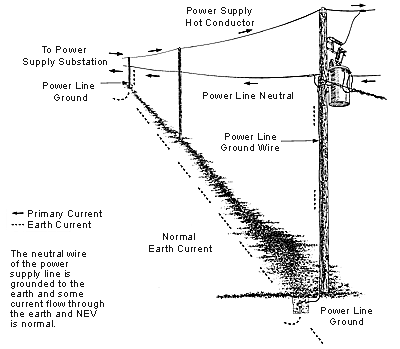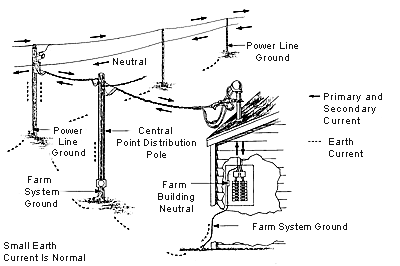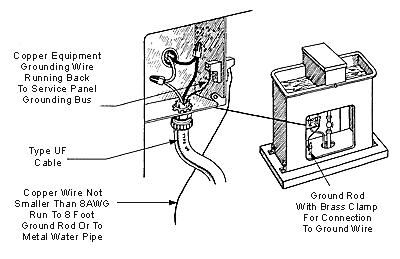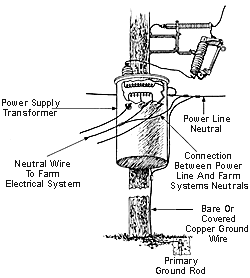Electrical power is both a vital resource on the farm and a potential source of problems if not properly managed. The more you understand about how electricity flows on the farm, the better you will be able to monitor this essential component of farm operations. Knowing the fundamentals of electricity flow will also help you understand and prevent on-the-farm problems such as stray voltage or unsafe conditions.
For more information, contact WPS at 877-444-0888.
A quick primer
- Voltage is the pressure that pushes electrical current through wiring systems and electrical equipment.
- Electricity always returns to the source of the power supply (a transformer or substation).
- Electric current will use the paths of least resistance to return to the source.
- Electrical systems and supply systems are grounded to the earth. Grounding is necessary to ensure safety and reliability.
- The primary electrical system is the electrical system on the utility side of the transformer.
- When electrical current returns to the power supply substation through a neutral conductor (a power line or wire), it is normal for a small amount of current to also flow through the earth. This will result in a small voltage called neutral-to-earth voltage (NEV).
- When electrical current cannot flow through a neutral conductor, due to some type of damage or defect in the circuit, more current will use a path through the earth to return to the power supply. This increases the NEV, possibly to levels that may be measurable in cattle contact areas on farms.
WPS agricultural consultants are available to assist you anytime you believe you may be experiencing electrical problems, or when you're remodeling or building new facilities. Please call them for a free electrical system analysis of your farm.
Back to top
How electricity flows
Electric current always flows from a power supply to the equipment that is using it and then back to its source, completing a circuit as it moves along an electrical supply system. Every electrical supply system uses a neutral conductor to return the current to the supply source. In addition, this neutral conductor is grounded.
This approach creates a "path of low resistance" for the current to follow in returning to its source. Under normal conditions, when electrical current flows along the grounded neutral conductor, a small portion of the current also flows through the earth. This creates some neutral-to-earth voltage (NEV), a small but measurable amount of voltage at each point where the electrical system is grounded.
When damage to the neutral conductor occurs — whether caused by a storm, corrosion or a poor connection — electric current finds an alternate path to the supply source through the earth. This will result in higher levels of NEV, and can become a source of stray voltage.
Back to top
Electric service to the farm
The power lines to a farm typically have two conductors, or wires. One is the power supply (hot) conductor, used to carry primary electrical current out to the farm transformer. The second conductor, known as the power line neutral, carries the primary current back to the power supply substation.
According to Wisconsin regulations, the neutral conductor must be grounded to earth at nine locations for each mile of line via ground rods or similar means. Some NEV along the line is normal and expected. One or more supply transformers may supply electricity to a farm. The supply transformer is connected to the farm's electrical system.

Back to top
Grounding is important
A properly grounded electrical system offers protection from damage to the transformer and customer equipment. If lightning damages a farm's transformer, the fuse will blow, disconnecting the transformer and preventing extremely high levels of voltage from reaching the on-farm equipment.

The power line neutral of the power distribution line is normally connected to the farm system's neutral wire. This connection, made at the supply transformer, is vital to ensuring safety in the event of storms or other damage. However, it also means that some NEV from the power distribution line can travel onto the farm system neutral.

Grounding/bonding of cattle waterer
Back to top
Electric service to buildings
The same principles of electrical current flow apply to electrical systems that serve individual farm buildings. A building receives electrical power with one or two ungrounded (hot) wires and a neutral wire that is grounded to the earth, all connected to a power source such as a transformer. Grounding of the neutral wire is required by the electrical wiring code. The neutral conductor must be of adequate size for the load and must be in good repair to assure a low resistance path.

Back to top
Equipment grounding
For safety, electrically powered equipment must also be part of the grounding system. This is accomplished via grounding bonding. A separate, solid wire runs from the equipment all the way back to the electrical service panel. There, it connects to the grounded neutral, "bonding" the equipment.
The grounding wire may be bare or covered with green insulating material. It attaches to the electrical equipment's metal frame.
In the event of an electrical fault, this system safely conducts the fault current back to the electrical panel. There, it will trip the breaker, preventing high levels of NEV, which can cause fire, injury or electrocution. This is also why any metal in livestock facilities — such as water lines, stanchions or pipelines — must be bonded (grounded) to the barn's main service panel.
When equipment grounding is absent or damaged, the fault current will instead flow into the earth as its path to the source transformer. Electrical current faulting into the earth can even travel short distances from one property to a neighboring farm, a problem that often occurs when the ground fault is at a water system pump or drainage pump.
Every farm relies on electrical supply systems that are in good working order for the safe and consistent use of electric power. Farmers can help ensure the reliability of these systems through proper installation and maintenance of wiring and equipment by a qualified electrician.
Back to top